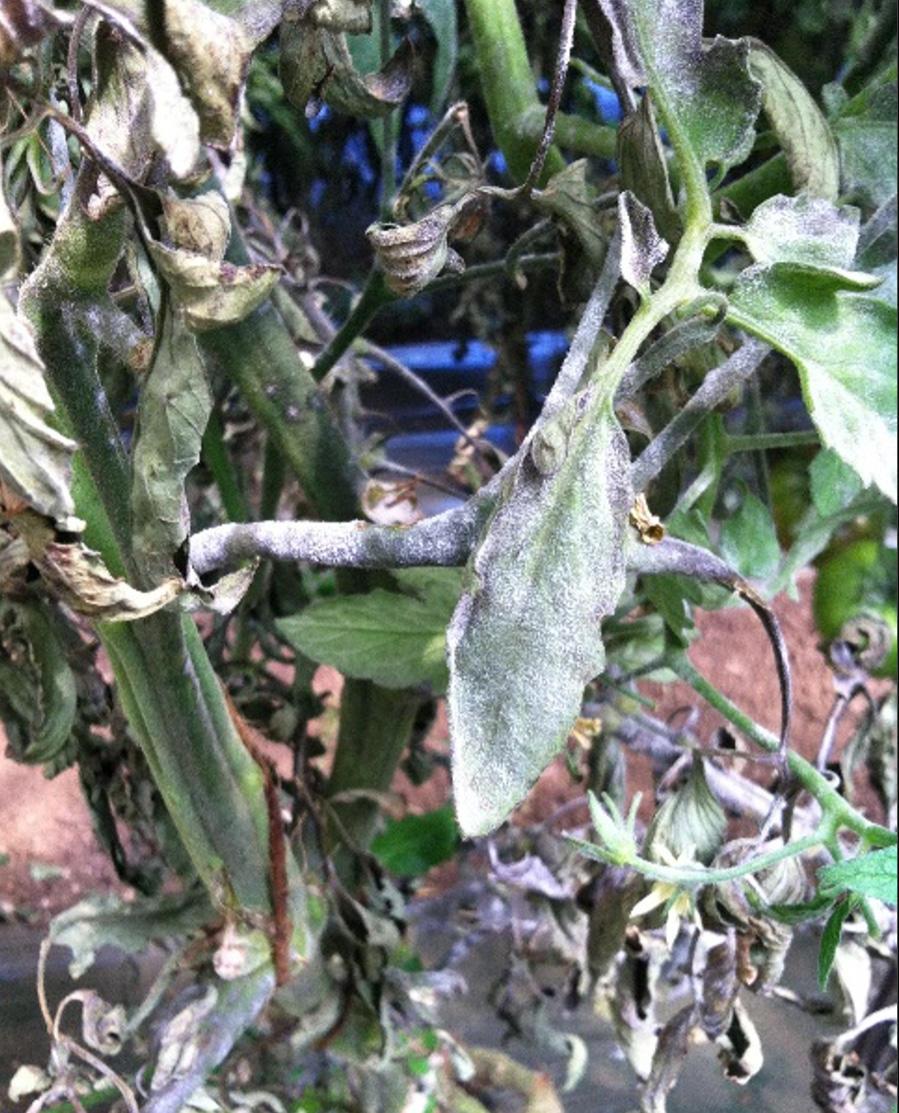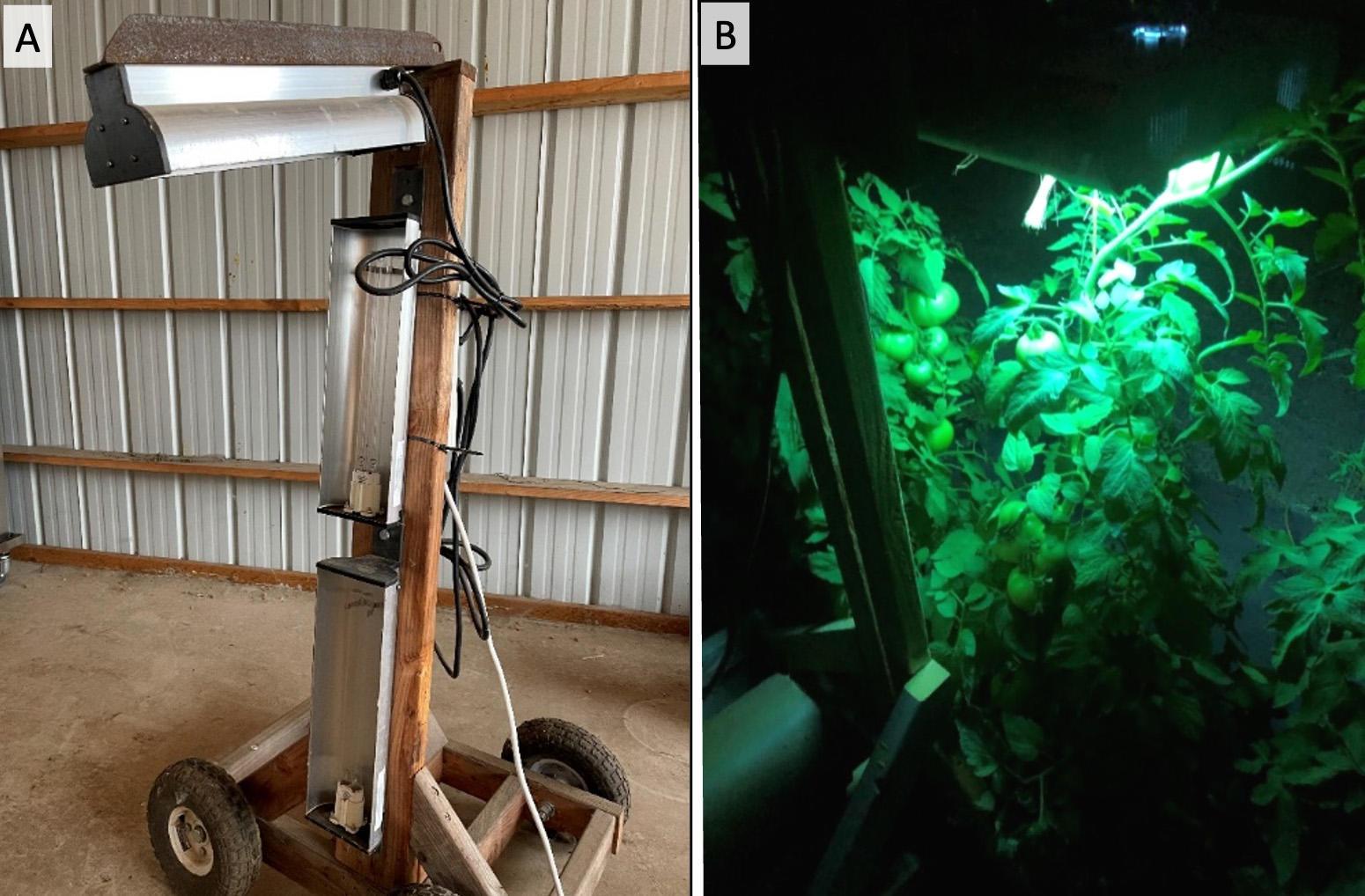Tomatoes are a high-value fresh market crop critical to farm income
Tomatoes (Solanum lycopersicum L.) are grown for fresh markets across the U.S. Tomato production in the Pacific Northwest is focused on fresh markets, and much of the acreage is grown under plastic or glass.
The USDA estimates 414 acres of production in Oregon with a farm value of over $14 million in 2009. Economic analysis of local market producers shows each 12 inches of tomato row can net $12 in current markets.
Nighttime temperatures below 55°F or above 75°F can severely impact tomato yields. This results in a decrease in fruit set, damage to young fruit or impact fruit size. The sensitivity to extreme temperatures makes tomato production under plastic or in a glasshouse a good option in western Oregon and Washington, where nighttime temperatures regularly drop below 54°F during the spring and early summer. For many fresh market growers, tomato sales are critical to the economic viability of the farm. Preventing crop loss due to pests and diseases is a critical need for small farms, especially those under organically certified cropping practices.
Tomato powdery mildew is a disease with potential for significant economic impacts
In recent years, widespread outbreaks of powdery mildew have been observed in fresh market tomato crops in western Oregon. Powdery mildew is caused by fungal pathogens that infect various crops, including tomatoes. Two fungi, Leveillula taurica (syns. Erysiphe taurica, Oidiopsis taurica) and Oidium neolycopersici (syn. Pseudoidium neolycopersici), can cause powdery mildew on tomatoes in western Oregon. Light green to bright yellow, irregularly shaped blotches develop on leaf surfaces, typically accompanied by a whitish sporulation on the upper or lower surface. Severely affected leaves may die and remain attached to plants (Figure 1). Powdery mildew can deform leaves if they are attacked before they are fully expanded.
Leveillula taurica, long known to incite powdery mildew on tomatoes and multiple crop genera in multiple plant families, usually is seen as a sparse, whitish powdery growth mostly on the underside of leaves. This fungus produces asexual spores (conidia) that are essential for disease spread (Fig. 2). Sexual spores produced in specialized fungal structures known as chasmothecia can be found, but chasmothecia are rarely observed in L. taurica.
Oidium neolycopersici has been more recently reported as a problem in tomatoes and other members of the Solanaceae family. Oidium neolycopersici produces a profuse, white powdery growth on the upper leaf surface. The underside of leaves can also have white, powdery growth when the relative humidity is high, such as in greenhouses or plastic high-tunnel hoop houses.
This fungus can lead to leaf death and severe defoliation of tomato plants. Oidium neolycopersici can also infect stems and petioles, unlike L. taurica, which is limited to leaves. Chasmothecia production by O. neolycopersici has not been reported, but conidia are produced in abundance and can incite new infections on plants in the vicinity. Oidium neolycopersici has been reported on tomatoes in California, Florida and other states and regions. Because Oregon growers obtain tomato transplants from other states, including California, Oregon producers can bring powdery mildew to farms via infected transplants.
Powdery mildew can overwinter on tomato or wild hosts, or survive as chasmothecia if produced. Conidia are readily windblown, so disease can spread by conidial dispersal from infected plants including from infections on overwintering wild hosts or transplants. Powdery mildew remains an economically important disease for enclosed tomato production because of market demands for unblemished fruit and the limited options for disease control in greenhouses and hoop houses. Although breeding programs are focused on providing resistant cultivars, high-market-value tomatoes, such as heirloom varieties and Roma-types, have poor resistance to powdery mildew. The varieties Geronimo F1, Granadero F1, Massada F1 and Striped Stuffer are reportedly resistant to powdery mildew.
While fungicides are registered for management of powdery mildew on tomatoes, much of the fresh market industry in the Pacific Northwest is organic. Organic growers and growers without organic certification have reported choosing minimal or no fungicide applications. They cite concerns for worker safety in enclosed areas such as greenhouses and hoop houses, as well as the high cost and logistical challenges of regular fungicide applications on tomato plants. But powdery mildew on tomatoes can be managed with consistent applications of protective or contact fungicides. A relatively large number of formulations that represent a range of active ingredients are registered for use on tomatoes in the Pacific Northwest. Find a current list of fungicides in the Pacific Northwest Plant Disease Handbook.
For growers with organic certification, options that can be effective for the management of tomato powdery mildew include Regalia tank-mixed with a copper formulation, potassium bicarbonates such as Kaligreen or Milstop, and a sulfur formulation (Microthiol Disperss) on seven-day intervals. Sulfur is toxic to fungi in its vapor phase and effective only when air temperatures promote volatilization (above 65°F). Sulfur becomes phytotoxic above 95°F, so using it above 85°F is not recommended. Potassium bicarbonates can be challenging to remove from spray equipment, so take extra care to thoroughly clean equipment. Oregon State University studies on potassium bicarbonate showed good control of tomato powdery mildew in high tunnel production in western Oregon. Kaligreen applied at 3 lb/A on weekly intervals prevented defoliation of tomato plants in 2019. Kaligreen reduced disease severity relative to nontreated tomato plants; mean percentage of leaf area with powdery mildew was 12% and 56% for Kaligreen-treated and nontreated plants, respectively, in 2019.
Powdery mildew fungi attacks can be severe on greenhouse tomatoes. Making regular fungicide applications to manage powdery mildew is difficult yet tomato crops are critical for farm income. An innovative management strategy for powdery mildew control, such as the use of ultraviolet lighting, may be of interest for tomato growers. In greenhouse settings, UV-B and UV-C light effectively reduced or eliminated powdery mildew in recent studies on tomatoes, cucumbers and strawberries. The germination of Oidium neolycopersici conidia was greatly reduced or eliminated following exposure to UV treatments in a 2016 study; results depended on treatment duration and UV wavelength. Short-duration UV light treatments followed by periods of darkness yielded the most effective disease control in a 2017 study.
OSU studies on tomato powdery mildew mitigation strategies via UV-C
Two separate experimental trials (Study A and Study B) were conducted in the 2020 growing season in an Oregon State University high-tunnel hoop house at the North Willamette Research and Extension Center in Aurora, Oregon. Disease control treatments included a nontreated control, a grower standard of potassium bicarbonate and UV-C. Treatments were applied to plots of 10 plants with four replications of each treatment plot.
Researchers placed a series of three lights that produce broadband UV-C at 253.7 nm (CleanLight XL, Netherlands), each 24 inches by 5 inches, , arranged on a stand measuring 60 inches tall. Two lights were placed vertically, parallel with the plant stem, and the third light was placed on a horizontal arm holding the light over the plant canopy (Figure 3A). The stand could be rolled across the ground in the greenhouse to apply the light to the side of the plants nearest the outside of the bed and above individual plants (Figure 3B). Plants in each plot initially received 90 seconds of UV light for the first two treatments in Study A. The exposure was reduced to 60 seconds of UV light per plant for the remainder of this run due to plant injury (Figure 4). UV-C treatment time was reduced to 60 seconds per plant twice a week in Study B. UV-C treatments were applied after sunset, beginning at official sunset on each treatment date and twice a week throughout each study.Research has shown fungi are most susceptible to damage from UV-C lights after sunset.
A recommended grower standard, potassium bicarbonate (Milstop, BioWorks), was applied at 3 lb/A each week using a hand-held sprayer in a volume equivalent to 288 gal water/A. Researchers recorded visual assessments of the percentage of leaf area with powdery mildew weekly for 10 compound leaves on each of the eight tomato plants in each plot. Plant height, fruit count and leaf chlorophyll content were determined for two plants in each plot at the end of each study.
Disease control study results
Powdery mildew spread rapidly within the hoop house in both studies. Both weekly applications of potassium bicarbonate and twice-weekly UV-C treatments reduced powdery mildew, and UV-C provided greater disease control. UV-C treatment resulted in no disease on all assessment dates in Study A. In Run 2, UV-C resulted in no disease on the first two assessment dates and less than 50% on the third and fourth assessment dates.
UV-C appears promising for the protection of tomatoes from powdery mildew in high-tunnel production in western Oregon. It is expected that a fine-tuned UV-C treatment would result in excellent disease control with negligible impact on overall crop yield and fruit quality compared to nontreated plants or plants treated with potassium bicarbonate on a weekly basis. In addition, UV-C may allow an extended growing period for spring-planted tomatoes grown under plastic in western portions of the Pacific Northwest.
Treatment effects on plant growth
In both studies, leaf chlorophyll content reported as SPAD ratings were not different among treatments. However, treatments did result in differences in plant height and number of fruits. In the first study, the UV-C treatment had shorter plants than the other two treatments. Also, UV-C significantly impacted the number of fruit per plant in Study A. The UV-C treated plants had the lowest number of fruit per plant and yield was significantly lower than the potassium bicarbonate treatment used as the grower standard. The potassium bicarbonate treatment had the highest number of fruit per plant; the number of fruit per plant was similar between the untreated plants and the UV-C-treated plants. In Study B, the length of time each plant was treated with UV-C light was reduced to minimize negative impacts on plant growth and fruit set. In this study run, there were no treatment differences in plant height or number of fruits.
Conclusions on preliminary evaluations of UV-C treatment effects on tomato powdery mildew
Two study runs comparing UV-C applications to weekly potassium bicarbonate applications conducted within a high-tunnel environment showed that a twice-weekly application of UV-C light protects tomato plants against powdery mildew. The studies showed that UV-C can be applied in a way that minimizes plant injury. Our work demonstrates the potential for UV-C as an option for the management of tomato powdery mildew. More research is needed to refine the treatment duration and application methods to prevent plant injury, maximize the benefit of UV-C light treatment and automate the process to prevent worker exposure to UV lights.
Acknowledgements
This research was funded by Oregon State University and the Agricultural Research Foundation. Many thanks to the dedicated help of our research technician Joe Battilega and students Sierra Burnell and Kayleigh Shear.
References
Arredondo, C.R., R.M. Davis, D.M. Rizzo and R. Stahmer. 1996. First report of powdery mildew of tomato in California caused by an Oidium sp. Plant Disease 80:1303.
Correll, J., T. Gordon and V. Elliott. 1988. The epidemiology of powdery mildew on tomatoes. California Agriculture 42:8-10.
Elizondo, R., and E. Oyanedel. 2010. Field testing of tomato chilling tolerance under varying light and temperature conditions. Chilean Journal of Agricultural Research 70(4):552-558.
Jacob, D., D. Rav David,A. Sztjenberg and Y. Elad. 2008. Conditions for development of powdery mildew of tomato caused by Oidium neolycopersici. Phytopathology 98:270-281.
Farr, D.F. and A.Y. Rossman. Fungal Databases, U.S. National Fungus Collections, ARS, USDA. Retrieved Feb. 17, 2022.
Janisiewicz, W. J., F. Takeda, B. Nichols, D.M. Glenn, W.M. Jurick II and M.J. Camp. 2016. Use of low-dose UV-C irradiation to control powdery mildew caused by Podosphaera aphanis on strawberry plants. Canadian Journal of Plant Pathology 38(4):430-439.
Kiss, L., S. Takamatsu, S. and J.H. Cunnington. 2005. Molecular identification of Oidium neolycopersici as the causal agent of the recent tomato powdery mildew epidemics in North America. Plant Disease 89:491-496.
Kiss, L., R.T.A. Cook, G.S. Saenz, J.H. Cunnington, S. Takamatsu, S., I. Pascoe,M. Bardin, P.C. Nicot, Y. Sato and A.Y. Rossman. 2001. Identification of two powdery mildew fungi, Oidium neolycopersici sp. nov. and O. lycopersici, infecting tomato in different parts of the world. Mycological Research 105(6):684-697.
Marois, J.J., M.T. Momol, J.W. Kimbrough, R.C. Hochmuth and W. Dankers. 2001. First report of powdery mildew on greenhouse tomatoes caused by Oidium neolycopersici in Florida. Plant Disease 85:1292.
Salvucci, A., B.J. Aegerter, E.M. Miyao, and I. Stergiopoulos. 2016. First report of powdery mildew caused by Oidium lycopersici in field-grown tomatoes in California. Plant Disease 100:1497.
Sato, S., H. Furukawa, H. Ikeda, N. Makita, M. Kamiyama and T. Iwata. 2006. Moderate increase of mean daily temperature adversely affects fruit set of Lycopersicon esculentum by disrupting specific physiological processes in male reproductive development. Annals of Botany 97:731-738.
Suthaparan, A., K.A. Solhaug, A. Stensvand, A. and H.R. Gislerød. 2016. Determination of UV action spectra affecting the infection process of Oidium neolycopersici, the cause of tomato powdery mildew. Journal of Photochemistry Photobiology B: Biology 156:41-49.
Suthaparan, A., K.A. Solhaug., A. Stensvand and H.R. Gislerød. 2017. Daily light integral and day light quality: Potentials and pitfalls of nighttime UV treatments on cucumber powdery mildew. Journal of Photochemistry Photobiology B: Biology 175:141-148.
Suthaparan, A., A. Stensvand, K.A. Solhaug, S. Torre, K.H. Telfer, A.K. Ruud, L.M. Mortensen, D.M. Gadoury, R.C. Seem and H.R. Gislerød. 2014. Suppression of cucumber powdery mildew by supplemental UV-B radiation in greenhouses can be augmented or reduced by background radiation quality. Plant Disease 98:1349-1357.
Suthaparan, A., A. Stensvand, K.A. Solhaug,S. Torre, L.M. Mortensen, D.M. Gadoury, R.C. Seem and H.R. Gislerød. 2012. Suppression of powdery mildew (Podosphaera pannosa) in greenhouse roses by brief exposure to supplemental UV-B radiation. Plant Disease. 96:1653-1660.
Pscheidt, J.W., and C.M. Ocamb, senior editors. 2021. Tomato—Powdery Mildew. In Pacific Northwest Pest Management Handbook. Oregon State University. Accessed Feb. 22, 2022.
USDA, National Agricultural Statistics Service. U.S. Tomato Statistics. 2011. Accessed Feb. 18, 2022.









